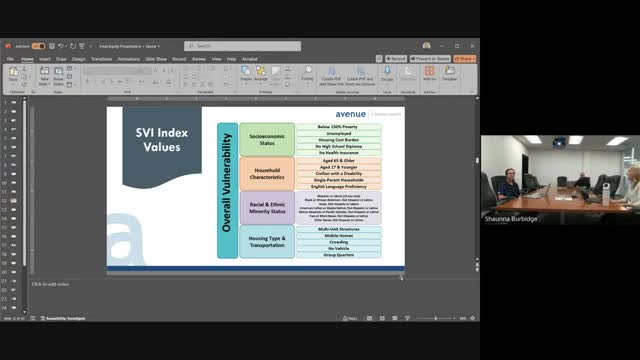Mapping Inequity Historic Redlining Linked to Social Vulnerability
October 13, 2024 | Utah Department of Transportation, Utah Government Divisions, Utah Legislative Branch, Utah
This article was created by AI summarizing key points discussed. AI makes mistakes, so for full details and context, please refer to the video of the full meeting. Please report any errors so we can fix them. Report an error »

In a recent government meeting, officials discussed the implications of the CDC's Social Vulnerability Index (SVI) in identifying areas of socioeconomic need across the state. The SVI evaluates various factors, including income levels, employment status, housing conditions, educational attainment, and household characteristics, to assess vulnerability within communities.
Key findings highlighted the correlation between historic redlining and current socioeconomic conditions. Officials presented a map illustrating 16 census tracts identified as equity focus areas, predominantly located in urban centers like Ogden and Salt Lake City, as well as in lower-income regions of southeastern Utah. The analysis revealed that these areas often overlap with those historically affected by redlining, indicating a persistent legacy of inequality.
The meeting emphasized the importance of expanding the focus beyond high-need areas to include a broader range of communities, encompassing approximately 20% of the state's tracts. This approach aims to better understand where investments and resources may be most beneficial.
Data analysis showed that areas with high SVI scores also reported more safety complaints and had a higher prevalence of complex road systems, including more signalized intersections and bike lanes. These findings suggest that while infrastructure improvements are being made, they may inadvertently overlook the needs of surrounding communities.
Officials also introduced a scoring system for the built environment, assessing factors such as the presence of schools, safety complaints, and pavement quality. Areas scoring four or more points out of a possible nine were flagged as having significant vulnerabilities, prompting further investigation into how these conditions affect residents' quality of life.
The meeting concluded with a commitment to further explore these findings and develop recommendations aimed at addressing the disparities highlighted by the SVI and built environment assessments.
Key findings highlighted the correlation between historic redlining and current socioeconomic conditions. Officials presented a map illustrating 16 census tracts identified as equity focus areas, predominantly located in urban centers like Ogden and Salt Lake City, as well as in lower-income regions of southeastern Utah. The analysis revealed that these areas often overlap with those historically affected by redlining, indicating a persistent legacy of inequality.
The meeting emphasized the importance of expanding the focus beyond high-need areas to include a broader range of communities, encompassing approximately 20% of the state's tracts. This approach aims to better understand where investments and resources may be most beneficial.
Data analysis showed that areas with high SVI scores also reported more safety complaints and had a higher prevalence of complex road systems, including more signalized intersections and bike lanes. These findings suggest that while infrastructure improvements are being made, they may inadvertently overlook the needs of surrounding communities.
Officials also introduced a scoring system for the built environment, assessing factors such as the presence of schools, safety complaints, and pavement quality. Areas scoring four or more points out of a possible nine were flagged as having significant vulnerabilities, prompting further investigation into how these conditions affect residents' quality of life.
The meeting concluded with a commitment to further explore these findings and develop recommendations aimed at addressing the disparities highlighted by the SVI and built environment assessments.
View full meeting
This article is based on a recent meeting—watch the full video and explore the complete transcript for deeper insights into the discussion.
View full meeting

